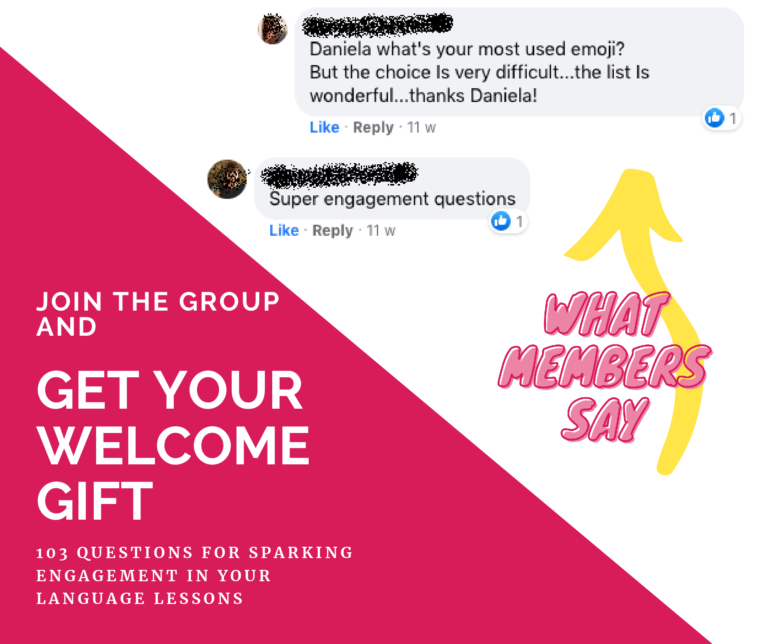
Striking up true conversations within language lessons can be challenging, if you don’t know how to do it. If that is your case, then what you need is a method and some ideas you can take inspiration from. Here is the ultimate list of 103 questions for sparking engagement in your language classes.
This article’s goal is to provide you with a few useful guidelines for you to make the most out of the list. Specifically, I’m going to answer the following questions:
- What are the 103 questions for?
- Where can you use the list?
- What type of questions is on the list?
- When exactly in your lessons could you use the questions on the list?
- How can you pick up the right question for your classes?
- How can you get the list?
1. What are the 103 questions for?
The 103 questions are perfect for:
- For encouraging the students to talk about relevant and meaningful topics
- For building a stronger teacher-students relationship
- For better getting to know the students’ interests, what they like and what they dislike, as well as their habits, wishes and opinion.
The great thing about the 103 questions is that they will help you to build trust. Remember that without true trust there is no engagement and, therefore, no smooth acquisition.
2. Where can you use the list?
Whether you do in person language lessons or online classes, the list is a brilliant collection of 103 questions that will encourage your students to take part in meaningful conversations. Also, the list is a very helpful tool even for those teachers who moderate online communities and groups of students, where we know engagement is the absolute king.
3. What type of questions can you find on the list?
The list consists of 103 open-ended questions. What do I mean by open-ended? Open-ended questions are questions that create movement in a group, encourage the people to speak up and to take part in the conversation. Also, those questions avoid yes/no closed-type-of answers. An example for closed-ended question is: “Do you like holidays?”. The answer could be yes or no, and the conversation would stop there. On the other hand, an example for open-ended questions is: “What is your favourite place for holidays?”. This is a type of question that encourages the students to talk and to share their thoughts.
I picked open-ended questions as the first out of five strategies described in the free guide Top 5 easy-to-implement strategies for getting your students to speak and engaged in your language lessons. If you haven’t got the free guide yet, I invite you to get it now:
4. When exactly in your lessons could you use the questions on the list?
The 103 question list is helpful if you are looking for fresh inspiration about how to kick off a class, be it either online or in person. I suggest to pick one question from the list, to strike up the conversation within your group through that question and then to take it from there for feeding the conversation.
In other words, the list is a perfect tool for the motivation (engage) phase of your language lesson. You can find out more about the phase called motivation, its goals and purpose in this blog’s post: How to plan the perfect language lesson.
5. How can you pick the right question for your classes?
This really depends on the outcome you aim at for a class. From this point of view, two scenarios open up:
- a) In the first scenario you want to stick to the class topic as much as possible. In this case, you may want to pick a question (or a few questions around the same topic) that will help you to introduce the topic in a conversational and informal way.
- b) In the second scenario you want to warm up the group, kick the lesson off in a fun way, or just to break the ice for creating relationship (and trust). You may want to do this in order to solidify the interaction with your students beyond the didactics. This is time totally well spent, believe me. Students groups are, first of all, communities of people. Meaning, they have got interests and identities. The question for us, teachers, about this point is: do we know enough the people we are teaching?
Have a thought about that. If you are not sure about what topic to approach, try with facts and news you know might be relevant to your students.
How can you get the list?
I created the list specifically for my Facebook group called Independent Language Teachers Collective – get students to speak & engaged. You are very welcome to join us anytime! Below you can find the link to the post where I attached the 103 question list. Join us, get the list and stay with us for tons of free training and good networking with peers.

Join Facebook Group & Get List
Conclusions
Briefly, the list is a great tool for boosting the students’ engagement in your language classes. What question to pick depends entirely on your expectations: you might want to pitch a new topic or to get to know better your students. In both cases, thanks to the 103 questions you are going to build trust, which is an essential starting point if you are looking to take your students to next level.


